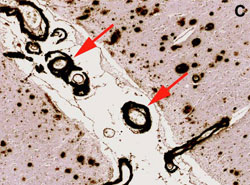Research
We use a range of complementary methods (e.g. histology, immunohistochemistry, genomics, transcriptomics and proteomics) to study brain tissue from patients with different forms of dementia and from normal controls. We also study the properties of cells in culture, modelling particular aspects of disease. Our research is conducted in a very positive environment with a strong emphasis on training and collaboration.
Our main areas of interest are in (i) mediators and pathways involved in regulating blood flow in the brain and how these are altered in different diseases that cause dementia, and (ii) the processes involved in the production, clearance and degradation of Aβ peptide the accumulation of which initiates damage to the brain in Alzheimer’s disease and to cerebral blood vessels in Cerebral Amyloid Angiopathy.
We are also study Lewy Body Dementia and forms of Vascular Cognitive Impairment, developing ways of measuring vascular damage and its effects on the brain, including interactions with biochemical pathways that are central to the development and progression of different types of dementia.
Our brain tissue research is underpinned by our oversight and use of the South West Dementia Brain Bank (SWDBB).
We are also undertaking research to harmonise methods for post-mortem assessment Cerebral Amyloid Angiopathy and Vascular Cognitive impairment, and for conceptualising and classifying various forms of Vascular Cognitive Impairment in clinical settings.
Donate to the Dementia Research Group
(to ensure your donations finds its way appropriately to the Dementia Research Group, please click the link below and then in the comments box on the form that appears on the next page - "To Support the Dementia Research Group in the School of Clinical Sciences")



